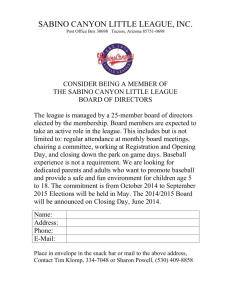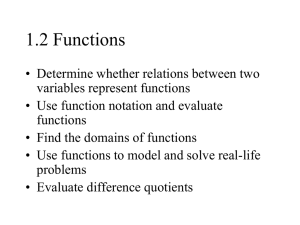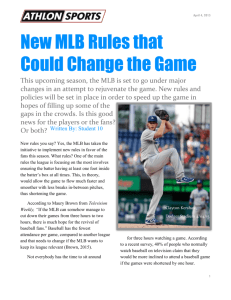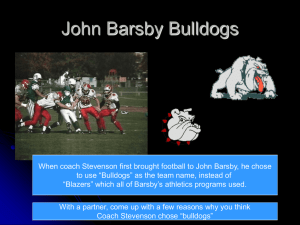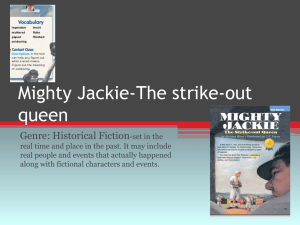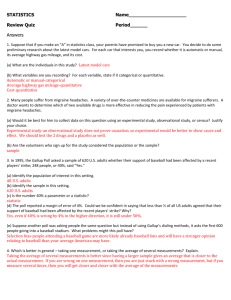Baseball Stadium Sustainability
advertisement
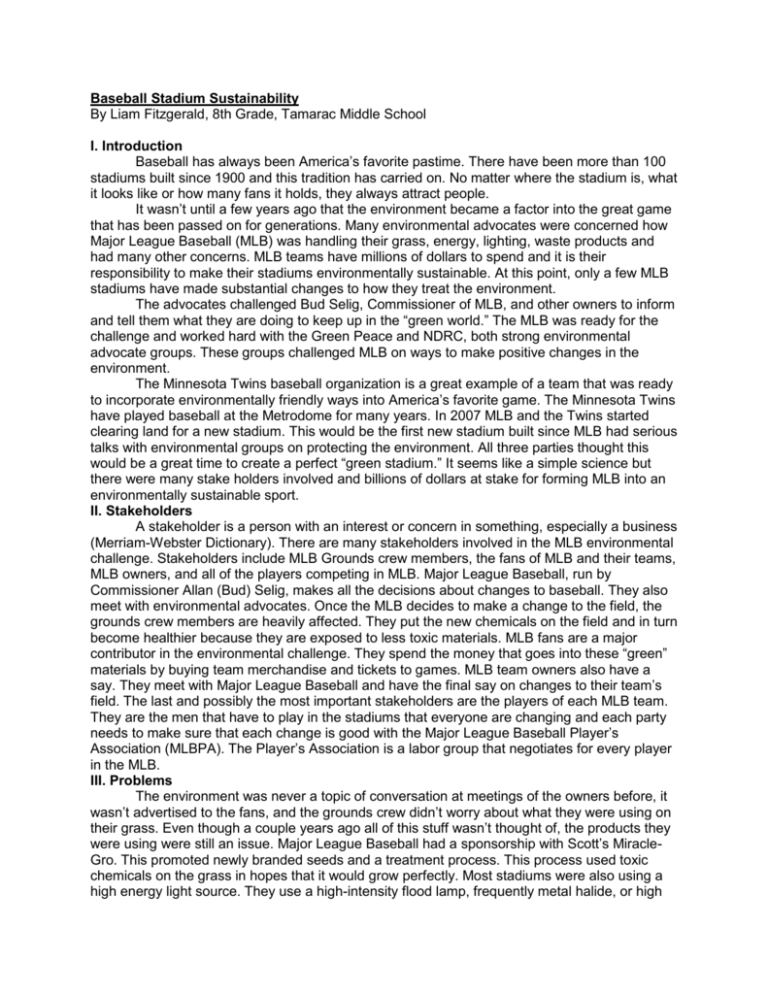
Baseball Stadium Sustainability By Liam Fitzgerald, 8th Grade, Tamarac Middle School I. Introduction Baseball has always been America’s favorite pastime. There have been more than 100 stadiums built since 1900 and this tradition has carried on. No matter where the stadium is, what it looks like or how many fans it holds, they always attract people. It wasn’t until a few years ago that the environment became a factor into the great game that has been passed on for generations. Many environmental advocates were concerned how Major League Baseball (MLB) was handling their grass, energy, lighting, waste products and had many other concerns. MLB teams have millions of dollars to spend and it is their responsibility to make their stadiums environmentally sustainable. At this point, only a few MLB stadiums have made substantial changes to how they treat the environment. The advocates challenged Bud Selig, Commissioner of MLB, and other owners to inform and tell them what they are doing to keep up in the “green world.” The MLB was ready for the challenge and worked hard with the Green Peace and NDRC, both strong environmental advocate groups. These groups challenged MLB on ways to make positive changes in the environment. The Minnesota Twins baseball organization is a great example of a team that was ready to incorporate environmentally friendly ways into America’s favorite game. The Minnesota Twins have played baseball at the Metrodome for many years. In 2007 MLB and the Twins started clearing land for a new stadium. This would be the first new stadium built since MLB had serious talks with environmental groups on protecting the environment. All three parties thought this would be a great time to create a perfect “green stadium.” It seems like a simple science but there were many stake holders involved and billions of dollars at stake for forming MLB into an environmentally sustainable sport. II. Stakeholders A stakeholder is a person with an interest or concern in something, especially a business (Merriam-Webster Dictionary). There are many stakeholders involved in the MLB environmental challenge. Stakeholders include MLB Grounds crew members, the fans of MLB and their teams, MLB owners, and all of the players competing in MLB. Major League Baseball, run by Commissioner Allan (Bud) Selig, makes all the decisions about changes to baseball. They also meet with environmental advocates. Once the MLB decides to make a change to the field, the grounds crew members are heavily affected. They put the new chemicals on the field and in turn become healthier because they are exposed to less toxic materials. MLB fans are a major contributor in the environmental challenge. They spend the money that goes into these “green” materials by buying team merchandise and tickets to games. MLB team owners also have a say. They meet with Major League Baseball and have the final say on changes to their team’s field. The last and possibly the most important stakeholders are the players of each MLB team. They are the men that have to play in the stadiums that everyone are changing and each party needs to make sure that each change is good with the Major League Baseball Player’s Association (MLBPA). The Player’s Association is a labor group that negotiates for every player in the MLB. III. Problems The environment was never a topic of conversation at meetings of the owners before, it wasn’t advertised to the fans, and the grounds crew didn’t worry about what they were using on their grass. Even though a couple years ago all of this stuff wasn’t thought of, the products they were using were still an issue. Major League Baseball had a sponsorship with Scott’s MiracleGro. This promoted newly branded seeds and a treatment process. This process used toxic chemicals on the grass in hopes that it would grow perfectly. Most stadiums were also using a high energy light source. They use a high-intensity flood lamp, frequently metal halide, or high intensity discharge lamps. The wattage may be as high as 2,000w per bulb. Water was also a highly consumed product. It is predicted that approximately 10 million gallons of water is used at professional baseball stadiums each year. Another problem was that many stadiums were not using any kind of recycling program. Fans make lots of food waste and various other types of waste product to be recycled. There were garbage cans at the stadium, but no type of recycling program. Another growing problem with some of the baseball stadiums was that they used artificial turf on the fields which let off toxic chemicals. Another major issue with stadiums is their strong connection to global warming. Global warming is the increase in the earth’s average atmospheric temperature that causes corresponding changes in climate and that may result from the greenhouse effect. The connection may be linked to the stadiums overuse of energy, CO2, and fossil fuels. It is the everyday materials used by all Major League Baseball teams that are getting people worried. Lawn mowers are used before, after, and even during games every day. Some of these mowers are running on dangerous and toxic fossil fuels that emit harmful toxins into the environment. The stadium lights are also a form of harmful energy use. This energy transmits CO2 into the air and eventually has a very negative impact on our natural environment. Another thought on how baseball can have a connection to global warming is fan transportation. Most baseball fans travel a long distance by car to see their favorite team and the stadium. All the cars enter the stadium releasing fumes and pollution all throughout the area. This has a major effect on the environment. IV. Solutions There have been various efforts from Major League Baseball to find solutions to the environmental problems of baseball stadiums. Examples of these efforts are a rainwater harvesting program in Minnesota, almost all stadiums have a type of recycling program, some stadiums have agreed on using safer pesticides on the field, and more and more ideas are coming out on the big challenge on how to preserve energy used to light up the stadiums for daily night game. Energy consumption has always been a major issue in the discussion of making the sport of baseball “greener”. Many advocates argue for a new type of florescent lights, while Major League Baseball is always arguing for the cheapest plan on the market. A minor league baseball team from Class A Advanced in a small city of Wilmington, Delaware is setting a good example for teams above them. The Wilmington Blue Rocks, minor league affiliate of the Kansas City Royals, currently play at Frawley Stadium. In the past few years, the Blue Rocks organization were informed on new methods for making their stadium more eco-friendly. The Kansas City Royals agreed that this would be an great opportunity to have one of their minor league ballparks be a pioneer in baseball’s attempt to “go green”. Before 2011, Frawley Stadium was using an outdated T12 fluorescent light bulb. These 4-lamp light bulbs were relatively inefficient compared to some of the newer light bulbs on the market. The T12 light bulb was banned from being sold in 2009 by the United States Department of Energy due to its inefficiency and destruction to the environment. In January of 2011, the organization announced that it was proud to be partnered with City Electric Supply (CES) by selected the T5 Retrofit Kit to light their stadiums for future games. The T5 Retrofit lighting is the most energy-efficient lighting solution on the market. “We have been exploring ways to improve energy- efficiency and these two companies have provided a great, cost effective solution for us," said Blue Rocks assistant general manager Andrew Layman. The order included 250 T5 Retrofit Kits, renovating 125 lighting fixtures on the premises, reducing the facilities lighting costs by 68% annually. The organization will receive a $5,500 energy-efficiency lighting rebate from the Delaware Sustainable Energy Utility (SEU), a nonprofit set up to help residents and businesses save energy and money while creating new jobs. The Blue Rocks retrofit project will deliver a complete return on investment in less than 12 months. (All information from “The Green Savings Company LLC”) Major League Baseball teams are also pitching in to help the environmental problems with stadium lights. Progressive Field, home of the Cleveland Indians, became only the second major league ball park (AT&T Park in San Francisco being the first) to install solar panels in 2008. Since that time many other ballparks installed solar panels. Kauffman Stadium, home of the Kansas City Royals, was the most recent ballpark to install solar panels just putting them in this past year. The Royals have been given the opportunity to host the 2012 Major League Baseball All Star Game. Kansas City Power and Light Co. (KCP&L) has installed a 28.8-kilowatt solar array that will generate about 36,000 kilowatt hours of renewable energy a year. That’s enough electricity to power four average homes annually, a KCP&L spokeswoman said. “The Royals are committed to making Kauffman Stadium one of the most environmentally friendly facilities in sports,” Kevin Uhlich, Royals senior vice president of business operations, said in a written statement. “We are excited to partner with KCP&L to bring the latest technologies in sustainable energy to the ballpark, especially as we prepare for the 2012 All-Star Summer.” The second major issue that has been presented to Major League Baseball is water consumption. Water is a transparent, odorless, tasteless liquid, compound of hydrogen and oxygen (H20), it freezes at 32 degrees Fahrenheit (Dictionary.com). It is important to cut down on the amount of water consumption is because it is a resource that the world will one day run out of and as a world we need to work on saving this valuable resource. According to EarthTechling.com, the Minnesota Twins and every other Major League Baseball team use approximately 10 million gallons of water to run their stadium each year. The Minnesota Twins and Washington Nationals are both LEED (Leadership in Energy and Environmental Design) certified stadiums partly because of their rain water harvesting program. This system is important in reducing water consumption because it uses precipitation. It is made of sand and mimics wetland by naturally filtering pollutants from the water, cleans and separates rainwater (washingtonnationals.com). The New York Mets also helped the cause by installing hands-free faucets and waterless urinals in Citi Field, built in 2009. I believe that Major League Baseball has already taken a giant leap into turning baseball stadiums into eco-friendly places, but I still think that they have a way to go until being completely there. I think that the MLB should work on all stadiums so they all have some kind of improvement. Major League Baseball seems to be focusing on more new stadiums, but I believe they should take all thirty big league ballparks and take the environmental money and put something eco-friendly, for example recycling, in all stadiums. These will jumpstart the campaign and hopefully bring all stadiums into big projects such as the rainwater harvesting program. V. Closing I want to close this report by having you imagine a world where every baseball stadium has a renewable energy source, closed-loop waterways, a reliable recycling program, and environmentally friendly ways to maintain the grass in the outfield. The Twins worked hard on their new stadium and were very excited to be playing in it by 2010. This was also a big milestone for MLB and environmental advocates. Target Field was awarded the LEED Silver certification. The LEED Silver Award is one of the most prestigious awards any building can receive from an environmental standpoint. A major feature that helped them achieve this award was their rain water harvesting program. This is an underground contraption that collects rain water and other precipitation and filters it. Once it is filtered, it is brought to the surface where the Minnesota Twins can use it for hosing down the field, washing their thousands of seats or washing anything else in the stadium. This is an amazing milestone, not only for the Twins, but for the world. This is proof that baseball stadiums can “GO GREEN.” Several stadiums, such as Fenway Park, Safeco Field, Marlin Stadium and Nationals Park in DC, have followed Target Field in the attempt to make their stadium more eco-friendly. The hope is for one day every baseball park will be just like Minnesota’s Target Field.
